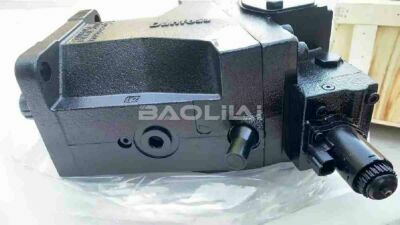Working principle and industrial application of hydraulic motor multi-cylinder action circuit
Multi-cylinder action circuits in hydraulic motor systems involve the use of multiple hydraulic cylinders to drive the hydraulic motor. This arrangement is commonly used in a variety of industrial applications that require high torque and smooth operation. A hydraulic motor is a device that converts hydraulic energy (fluid pressure) into mechanical rotation and can be used to drive various mechanical equipment.
The following is a general overview of a hydraulic motor multi-cylinder action circuit:
1. Hydraulic Pump: This system starts with a hydraulic pump that creates hydraulic pressure by sucking in hydraulic fluid (usually oil) and pressurizing it. Hydraulic pumps are usually driven by electric motors or internal combustion engines.
2. Control valve: The control valve is used to control the flow of hydraulic oil to each hydraulic cylinder. These valves can be manually operated, electrically controlled or automated using a PLC (Programmable Logic Controller).
3. Hydraulic motor: A hydraulic motor is a component that converts hydraulic energy into mechanical rotation. It usually consists of a rotor driven by hydraulic oil and an output shaft that transmits mechanical power to the driven machinery.
4. Hydraulic cylinder: Multiple hydraulic cylinders are used to act on the hydraulic motor. These hydraulic cylinders are usually arranged in a circular or radial pattern, with each cylinder applying force to a specific point on the hydraulic motor rotor. As hydraulic cylinders extend and retract, they create a rotational motion in the hydraulic motor.
5. Feedback and control system: In order to ensure the synchronization and precise movement of the hydraulic cylinder, a feedback and control system can be adopted. The system can use sensors to monitor the position of the hydraulic cylinder and adjust the flow of hydraulic oil accordingly.
H1-B-060-A-A-E2-AA-N-B-TB-CN-GN-N-N-NN-NN-026-Z-00-NNN H1B060AAE2AANBTBCNGNNNNNNN026Z00NNN
H1-B-060-A-A-E2-AA-N-B-TB-CN-GN-N-N-NN-NN-024-R-00-NNN H1B060AAE2AANBTBCNGNNNNNNN024R00NNN
H1-B-060-A-A-E2-AA-N-B-TB-CN-GN-N-N-NN-NN-020-Z-00-NNN H1B060AAE2AANBTBCNGNNNNNNN020Z00NNN
H1-B-060-A-A-E2-AA-N-B-TB-CN-GN-N-N-NN-NN-020-Q-00-NNN H1B060AAE2AANBTBCNGNNNNNNN020Q00NNN
H1-B-060-A-A-E2-AA-N-B-TB-CN-GN-N-N-NN-NN-017-Z-00-NNN H1B060AAE2AANBTBCNGNNNNNNN017Z00NNN
H1-B-060-A-A-E2-AA-N-B-TB-CN-GN-N-N-NN-NN-012-Z-00-NNN H1B060AAE2AANBTBCNGNNNNNNN012Z00NNN
H1-B-060-A-A-E2-AA-N-B-TB-CN-GN-N-A-10-NN-036-Z-00-NNN H1B060AAE2AANBTBCNGNNA10NN036Z00NNN
H1-B-060-A-A-E2-AA-N-B-TB-CN-GN-N-A-10-NN-026-Z-00-NNN H1B060AAE2AANBTBCNGNNA10NN026Z00NNN
H1-B-060-A-A-E2-AA-N-B-TB-CN-GN-N-A-10-NN-012-Z-00-NNN H1B060AAE2AANBTBCNGNNA10NN012Z00NNN
H1-B-060-A-A-E2-AA-N-B-TB-CN-GN-N-A-05-NN-036-Z-00-NNN H1B060AAE2AANBTBCNGNNA05NN036Z00NNN
H1-B-060-A-A-E2-AA-N-B-TB-CN-GN-N-A-05-NN-032-Z-00-NNN H1B060AAE2AANBTBCNGNNA05NN032Z00NNN
H1-B-060-A-A-E2-AA-N-B-TB-CN-GN-N-A-05-NN-030-Z-00-NNN H1B060AAE2AANBTBCNGNNA05NN030Z00NNN
H1-B-060-A-A-E2-AA-N-B-TB-CN-GN-N-A-05-NN-025-S-00-NNN H1B060AAE2AANBTBCNGNNA05NN025S00NNN
H1-B-060-A-A-E2-AA-N-B-TA-VS-AS-S-N-NN-NN-020-Z-00-NNN H1B060AAE2AANBTAVSASSNNNNNN020Z00NNN
H1-B-060-A-A-E2-AA-N-B-TA-VS-AS-S-A-10-NN-040-Z-00-NNN H1B060AAE2AANBTAVSASSA10NN040Z00NNN
H1-B-060-A-A-E2-AA-N-B-TA-VS-AS-S-A-05-NN-030-Z-00-NNN H1B060AAE2AANBTAVSASSA05NN030Z00NNN
H1-B-060-A-A-E2-AA-N-B-TA-VS-AS-S-A-05-NN-017-Z-00-NNN H1B060AAE2AANBTAVSASSA05NN017Z00NNN
H1-B-060-A-A-E2-AA-N-B-TA-VS-AS-S-A-05-NN-000-Z-00-NNN H1B060AAE2AANBTAVSASSA05NN000Z00NNN
H1-B-060-A-A-E2-AA-N-B-TA-VS-AS-P-A-05-NN-015-Z-00-NNN H1B060AAE2AANBTAVSASPA05NN015Z00NNN
H1-B-060-A-A-E2-AA-N-B-TA-VS-AS-B-A-05-NN-015-Z-00-NNN H1B060AAE2AANBTAVSASBA05NN015Z00NNN
6. Pressure relief and safety valve: Install a pressure relief valve in the system to prevent overpressure and ensure system safety. If the pressure exceeds a set limit, these valves open to relieve the excess pressure.
7. Fluid storage tank: The fluid storage tank holds the hydraulic oil and allows heat dissipation and filtration to maintain the quality of the hydraulic oil.
Working principles:
1. Synchronization: The key to a multi-cylinder action circuit is to ensure that all hydraulic cylinders act in a coordinated manner so that the hydraulic motor produces smooth and continuous rotation. This is usually accomplished by controlling the flow of hydraulic fluid to each cylinder via a control valve.
2. Sequential action: The control valve can be controlled to extend and retract the hydraulic cylinder in a specific sequence. For example, if you have four cylinders arranged in a circular pattern, you would extend cylinder 1, then cylinder 2, then cylinder 3, and finally cylinder 4. This sequence creates a continuous rotational force on the hydraulic motor.
3. Direction control: By reversing the direction of hydraulic oil flowing to the cylinder, the rotation direction of the hydraulic motor can be changed.

advantage:
1. High torque: The multi-cylinder action circuit can provide high torque output, suitable for heavy-duty applications requiring high power.
2. Smooth operation: The synchronized action of the cylinders ensures smooth, continuous rotation, which is very important for applications where vibration problems may occur.
3. Precise control: The speed and position of the hydraulic motor can be precisely controlled using control valves and feedback systems.
4. Redundancy: In some applications, redundancy is important for safety and performance. If one cylinder fails, the other cylinders can usually compensate for the loss of power.
5. Efficiency: Hydraulic systems can be very efficient, especially when using variable displacement pumps and other energy-saving features.
H1-B-060-A-A-E2-AA-N-B-TA-VN-BN-N-N-NN-NN-022-Z-00-NNN H1B060AAE2AANBTAVNBNNNNNNN022Z00NNN
H1-B-060-A-A-E2-AA-N-B-TA-VN-AN-N-N-NN-NN-030-Z-00-NNN H1B060AAE2AANBTAVNANNNNNNN030Z00NNN
H1-B-060-A-A-E2-AA-N-B-TA-VN-AN-N-N-NN-NN-015-Z-00-NNN H1B060AAE2AANBTAVNANNNNNNN015Z00NNN
H1-B-060-A-A-E2-AA-N-B-TA-DS-GS-S-N-NN-NN-030-Z-00-NNN H1B060AAE2AANBTADSGSSNNNNN030Z00NNN
H1-B-060-A-A-E2-AA-N-B-TA-DS-GS-B-N-NN-NN-020-Z-00-NNN H1B060AAE2AANBTADSGSBNNNNN020Z00NNN
H1-B-060-A-A-E2-AA-N-B-TA-DN-GN-N-N-NN-NN-030-Z-00-NNN H1B060AAE2AANBTADNGNNNNNNN030Z00NNN
H1-B-060-A-A-E2-AA-N-B-TA-DN-GN-N-N-NN-NN-020-Z-00-NNN H1B060AAE2AANBTADNGNNNNNNN020Z00NNN
H1-B-060-A-A-E2-AA-N-B-TA-CS-GS-P-A-05-NN-018-Z-00-NNN H1B060AAE2AANBTACSGSPA05NN018Z00NNN
H1-B-060-A-A-E2-AA-N-B-TA-CS-GS-B-N-NN-NN-020-Z-00-NNN H1B060AAE2AANBTACSGSBNNNNN020Z00NNN
H1-B-060-A-A-E2-AA-N-B-TA-CN-GN-N-N-NN-NN-020-Z-00-NNN H1B060AAE2AANBTACNGNNNNNNN020Z00NNN
H1-B-060-A-A-E2-AA-N-B-TA-CN-GN-N-N-NN-NN-014-Z-00-NNN H1B060AAE2AANBTACNGNNNNNNN014Z00NNN
H1-B-060-A-A-E2-AA-N-B-TA-CN-GN-N-A-05-NN-035-Z-00-NNN H1B060AAE2AANBTACNGNNA05NN035Z00NNN
H1-B-060-A-A-E2-AA-N-A-TB-VS-BS-S-A-10-NN-036-Z-00-NNN H1B060AAE2AANATBVSBSSA10NN036Z00NNN
H1-B-060-A-A-E2-AA-N-A-TB-VN-AN-N-N-NN-NN-030-Z-00-NNN H1B060AAE2AANATBVNANNNNNNN030Z00NNN
H1-B-060-A-A-E2-AA-N-A-TB-VN-AN-N-A-10-NN-016-Z-00-NNN H1B060AAE2AANATBVNANNA10NN016Z00NNN
H1-B-060-A-A-E2-AA-N-A-TB-CS-GS-S-A-10-NN-030-Z-00-NNN H1B060AAE2AANATBCSGSSA10NN030Z00NNN
H1-B-060-A-A-E2-AA-N-A-TB-CS-GS-S-A-05-NN-030-Z-00-NNN H1B060AAE2AANATBCSGSSA05NN030Z00NNN
H1-B-060-A-A-E2-AA-N-A-TB-CS-AS-S-A-10-NN-029-Z-00-NNN H1B060AAE2AANATBCSASSA10NN029Z00NNN
H1-B-060-A-A-E2-AA-N-A-TB-CS-AS-P-A-05-NN-020-Z-00-NNN H1B060AAE2AANATBCSASPA05NN020Z00NNN
H1-B-060-A-A-E2-AA-N-A-TB-CN-GN-N-A-05-NN-030-Z-00-NNN H1B060AAE2AANATBCNGNNA05NN030Z00NNN
Multi-cylinder action circuits of hydraulic motors are used in various industries:
1. Heavy machinery: Construction equipment, mining machinery and agricultural machinery often use multi-cylinder hydraulic systems due to their high torque and power.
2. Manufacturing: In the manufacturing process, hydraulic systems are used for precision control of machining, stamping, and material handling equipment.
3. Marine Industry: Hydraulic systems are used for ship steering and other marine applications.
4. Aerospace: Aircraft landing gear and control surfaces can use hydraulic systems because of their reliability and high force output.
5. Renewable energy: Hydraulic actuators and electric motors are often used to adjust the blade angle of wind turbine blade pitch control systems.
6. Material handling: Cranes and forklifts can use hydraulic systems to lift and position heavy objects.
7. Automobiles: Some heavy-duty vehicles, such as trucks and buses, may use hydraulic systems for power steering and other functions.
Designing multi-cylinder action circuits for hydraulic motors requires careful design in order to achieve the required performance, reliability and safety. It is important to consider factors such as cylinder placement, fluid flow control, feedback systems and safety mechanisms to ensure smooth and precise operation. Additionally, regular maintenance and monitoring are critical to keeping your system in optimal working order.
This article is published by the official website of Baolilai Hydraulics, please contact the author and indicate the source for reprinting:https://www.baolilai-pump.cn/news/1135.html






